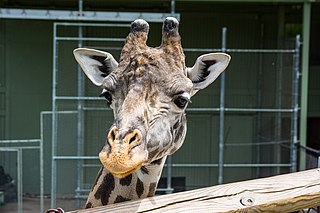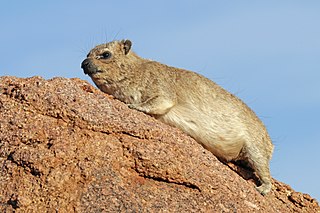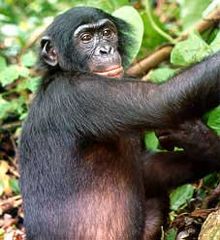
Bushmeat is meat from wildlife species that are hunted for human consumption. Bushmeat represents a primary source of animal protein and a cash-earning commodity in poor and rural communities of humid tropical forest regions of the world.

Virunga National Park is a national park in the Albertine Rift Valley in the eastern part of the Democratic Republic of the Congo. It was created in 1925. In elevation, it ranges from 680 m (2,230 ft) in the Semliki River valley to 5,109 m (16,762 ft) in the Rwenzori Mountains. From north to south it extends approximately 300 km (190 mi), largely along the international borders with Uganda and Rwanda in the east. It covers an area of 8,090 km2 (3,120 sq mi).

The Sedgwick County Zoo is an AZA-accredited wildlife park and major attraction in Wichita, Kansas, United States. Founded in 1971, with the help of the Sedgwick County Zoological Society, the zoo has quickly become recognized both nationally and internationally for its support of conservation programs and successful breeding of rare and endangered species. Having over 3,000 animals of nearly 400 species, the zoo has slowly increased its visitors and now ranks as the number one outdoor tourist attraction in the state.

Gladys Porter Zoo is a zoological and botanical park located in Brownsville, Texas, United States. The zoo officially opened on September 3, 1971, and currently averages over 424,000 visitors annually. Situated on 31 acres (13 ha), the zoo houses about 400 animal species and over 250 tropical and neo-tropical species and subspecies. It is the first zoo to have successfully bred the endangered Jentink's duiker. It is also the birthplace of Harambe, the gorilla.

Salonga National Park is a national park in the Democratic Republic of the Congo located in the Congo River basin. It is Africa's largest tropical rainforest reserve covering about 36,000 km2 or 3,600,000 hectares. It extends into the provinces of Mai Ndombe, Equateur, Kasaï and Sankuru. In 1984, the national park was inscribed on the UNESCO World Heritage List for its protection of a large swath of relatively intact rainforest and its important habitat for many rare species. In 1999, the site has been listed as endangered due to poaching and housing construction. Following the improvement in its state of conservation, the site was removed from the endangered list in 2021.

The Comoé National Park is a Biosphere Reserve and UNESCO World Heritage Site in the Zanzan and Savanes districts of northeastern Côte d'Ivoire. It is the largest protected area in West Africa, with an area of 11,500 square kilometers (4,400 sq mi), and ranges from the humid Guinea savanna to the dry Sudanian zone. This steep climatic north–south gradient allows the park to harbor a multitude of habitats with a remarkable diversity of life. Some animal and plant species even find their last sanctuary in some of the different savanna types, gallery forests, riparian grasslands, rock outcrops, or forest islands.

The Congolian rainforests are a broad belt of lowland tropical moist broadleaf forests which extend across the basin of the Congo River and its tributaries in Central Africa.

The American Species Survival Plan or SSP program was developed in 1981 by the (American) Association of Zoos and Aquariums to help ensure the survival of selected species in zoos and aquariums, most of which are threatened or endangered in the wild.

The San Antonio Zoo is an Association of Zoos and Aquariums-accredited zoo in Midtown San Antonio, Texas, United States. It is located in the city's Brackenridge Park. San Antonio Zoo is a 50+ acre zoo home to over 750 species, some of which are endangered or extinct in the wild, and an annual attendance of more than 1 million. It also runs non-animal attractions, such as the 2 ft narrow gauge San Antonio Zoo Eagle train ride, which first opened in 1956.

The wildlife of Ivory Coast consists of the flora and fauna of this nation in West Africa. The country has a long Atlantic coastline on the Gulf of Guinea and a range of habitat types. Once covered in tropical rainforest, much of this habitat has been cleared, the remaining terrain being gallery forests and savanna with scattered groups of trees, resulting in a decrease in biodiversity. As of 2016, 252 species of mammal had been recorded in Ivory Coast, 666 species of bird, 153 species of reptile, 80 species of amphibian, 671 species of fish and 3660 species of vascular plant.

The wildlife of Uganda is composed of its flora and fauna. Uganda has a wide variety of different habitats, including mountains, hills, tropical rainforest, woodland, freshwater lakes, swamps and savanna with scattered clumps of trees. The country has a biodiverse flora and fauna reflecting this range of habitats and is known for its primates, including gorillas and chimpanzees. There are ten national parks and thirteen wildlife reserves; some 345 species of mammal and 1020 species of bird have been recorded in the country.

The wildlife of Zambia refers to the natural flora and fauna of Zambia. This article provides an overview, and outline of the main wildlife areas or regions, and compact lists of animals focusing on prevalence and distribution in the country rather than on taxonomy. More specialized articles on particular groups are linked from here.

The wildlife of Togo is composed of the flora and fauna of Togo, a country in West Africa. Despite its small size the country has a diversity of habitats; there are only remnants of the once more extensive rain forests in the south, there is Sudanian savanna in the north-western part of the country and larger areas of Guinean forest–savanna mosaic in the centre and north-east. The climate is tropical with distinct wet and dry seasons. There are estimated to be over 3000 species of vascular plants in the country, and 196 species of mammals and 676 species of birds have been recorded there.

The Fauna of Africa, in its broader sense, is all the animals living in Africa and its surrounding seas and islands. The more characteristic African fauna is found in the Afro-tropical realm. Lying almost entirely within the tropics, and equally to north and south of the equator creates favorable conditions for rich wildlife. Africa is home to many of the world's most famous fauna in human culture such as lions‚ leopards, cheetahs‚ Spotted hyenas, African wild dog, African elephants, hippos, rhinos‚ Nile crocodile, Nile monitor, African rock python, Black mamba, Gaboon viper, Forest cobra, African spurred tortoises, African bullfrog, African civet, Honey badger, Meerkats, Banded mongoose, African clawless otters, Ground pangolins, Aardvark, Crested porcupines, Caracal, Serval, African wildcat, Black-backed jackal, Bat-eared foxs, Gorillas, Mandrills, Baboons, Chimpanzees, Vervet monkeys, Common warthogs, giraffes‚ African buffalo, Blue wildebeest, zebras‚ Thomson's gazelles, Impala, Kudus, East African oryx, Nyala, Waterbucks, Hartebeest, antelope, African fish eagles, Crowned eagles, White-backed vulture, African scops owl, Pygmy falcon, North African ostrich, Grey crowned crane, Saddle-billed stork, Marabou stork, Shoebill, African spoonbill, Black-headed heron, Greater flamingo, Namaqua sandgrouse, African penguins, and among many others.
Mont Sângbé National Park is a national park in Ivory Coast. The Encyclopædia Britannica lists it among the "principal national parks of the world". It acquired national park status in 1976.

Tourism in the Democratic Republic of the Congo is uncommon. Tourists can see wildlife, indigenous cultures, and geological phenomena not found easily or anywhere else in Africa.

















